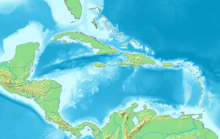
The American Revolutionary War saw a series of battles involving naval forces of the British Royal Navy and the Continental Navy from 1775, and of the French Navy from 1778 onwards. Although the British enjoyed more numerical victories, these battles culminated in the surrender of the British Army force of Lieutenant-General Earl Charles Cornwallis, an event that led directly to the beginning of serious peace negotiations and the eventual end of the war. From the start of the hostilities, the British North American station under Vice-Admiral Samuel Graves blockaded the major colonial ports and carried raids against patriot communities. Colonial forces could do little to stop these developments due to British naval supremacy. In 1777, colonial privateers made raids into British waters capturing merchant ships, which they took into French and Spanish ports, although both were officially neutral. Seeking to challenge Britain, France signed two treaties with America in February 1778, but stopped short of declaring war on Britain. The risk of a French invasion forced the British to concentrate its forces in the English Channel, leaving its forces in North America vulnerable to attacks.

Admiral John Holloway was an officer of the Royal Navy who saw service during the American War of Independence, and the French Revolutionary and Napoleonic Wars, before serving as Governor of Newfoundland between 1807 and 1809.

The Battle of Saint Kitts, also known as the Battle of Frigate Bay, was a naval battle fought on 25 and 26 January 1782 during the American Revolutionary War between a British fleet under Rear Admiral Sir Samuel Hood and a larger French fleet under the Comte de Grasse.

The Battle of Grenada took place on 6 July 1779 during the American Revolutionary War in the West Indies between the British Royal Navy and the French Navy, just off the coast of Grenada. A British fleet led by Admiral John Byron had sailed in an attempt to relieve Grenada, which the French forces of the Comte D'Estaing had just captured.
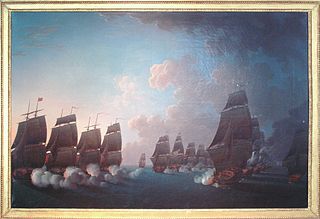
The Battle of Martinique, also known as the Combat de la Dominique, took place on 17 April 1780 during the American Revolutionary War in the West Indies between the British Royal Navy and the French Navy.

The Battle of Fort Royal was a naval battle fought off Fort Royal, Martinique in the West Indies during the Anglo-French War on 29 April 1781, between fleets of the British Royal Navy and the French Navy. After an engagement lasting four hours, the British squadron under Admiral Samuel Hood broke off and retreated. Admiral de Grasse offered a desultory chase before seeing the French convoys safe to port.

The Fantasque was a Lion-class 64-gun ship of the line of the French Navy. She is famous for being captained by the French commander Pierre-André de Suffren during the American Revolutionary War.

The Languedoc was a 80-gun ship of the line of the French Navy and flagship of Admiral d'Estaing. She was offered to King Louis XV by the Languedoc, as part of the Don des vaisseaux, a national effort to rebuild the navy after the Seven Years' War. She was designed by the naval architect Joseph Coulomb, and funded by a don des vaisseaux donation from the Estates of Languedoc.

The Battle of Genoa was a naval battle fought between French and allied Anglo-Neapolitan forces on 14 March 1795 in the Gulf of Genoa, a large bay in the Ligurian Sea off the coast of the Republic of Genoa, during the French Revolutionary Wars. The French fleet was led by Contre-amiral Pierre Martin and comprised 14 ships of the line while the British Royal Navy and Neapolitan fleet, under Vice-Admiral William Hotham mustered 13 ships of the line. The battle ended with a minor British-Neapolitan victory and the capture of two French ships.

HMS St Albans was a 64-gun third rate ship of the line of the Royal Navy, launched on 12 September 1764 by Perry, Wells & Green at their Blackwall Yard, London.
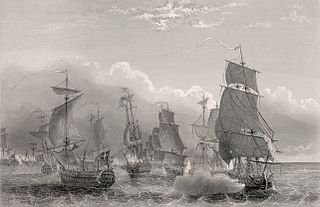
The Battle of Martinique, or Combat de la Martinique, was a naval encounter on 18 December 1779 between a British 13-ship squadron under Admiral Hyde Parker and a three-ship French division under Admiral Lamotte-Picquet near the island of Martinique in the West Indies.
HMS Boyne was a 70-gun third rate ship of the line of the Royal Navy, built at Plymouth Dockyard to the draught specified in the 1745 Establishment as amended in 1754, and launched on 31 May 1766. She was first commissioned for the Falkland Crisis of 1770 after which, in 1774, she sailed for North America. From March 1776, she served in the English Channel then, in May 1778, she was sent to the West Indies where she took part in the battles of St Lucia, Grenada and Martinique. In November 1780, Boyne returned home, where she was fitted for ordinary at Plymouth. In May 1783, she was broken up.

The Capture of Grenada was an amphibious expedition in July 1779 during the American Revolutionary War. Charles Hector, comte D'Estaing led French forces against the British-held West Indies island of Grenada. The French forces landed on 2 July and the assault occurred on the night of 3–4 July. The French forces assaulted the British fortifications on Hospital Hill, overlooking the island's capital, Saint George's. The British cannons were captured and turned against Fort George. British Governor Lord Macartney opened negotiations to surrender.

The Capture of St Lucia was the result of a campaign from 18–28 December 1778 by British land and naval forces to take over the island, which was a French colony. Britain's actions followed the capture of the British-controlled island of Dominica by French forces in a surprise invasion in September 1778. During the Battle of St. Lucia, the British fleet defeated a French fleet sent to reinforce the island. A few days later French troops were soundly defeated by British troops during the Battle of Morne de la Vigie. Realising that another British fleet would soon arrive with reinforcements, the French garrison surrendered. The remaining French troops were evacuated, and the French fleet returned to Martinique, another French colony. St. Lucia stayed in the hands of the British.
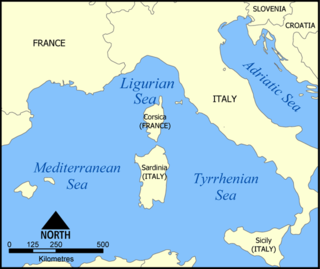
The Battle of the Hyères Islands was a naval engagement fought between a combined British and Neapolitan fleet and the French Mediterranean Fleet on 13 July 1795 during the French Revolutionary Wars. Since the start of the war in 1793 the French fleet had suffered a series of damaging defeats and was restricted to limited operations off the French Mediterranean Coast in the face of a determined allied blockade. The French fleet, commanded by Pierre Martin, had sought to test the blockade during 1795, and in March had been caught by the British, under William Hotham, in the Gulf of Genoa. At the ensuing Battle of Genoa two French ships were captured before Martin was able to retreat to a safe anchorage.

HMS Ceres was an 18-gun sloop launched in 1777 for the British Royal Navy that the French captured in December 1778 off Saint Lucia. The French Navy took her into service as Cérès. The British recaptured her in 1782 and renamed her HMS Raven, only to have the French recapture her again early in 1783. The French returned her name to Cérès, and she then served in the French Navy until sold at Brest in 1791.
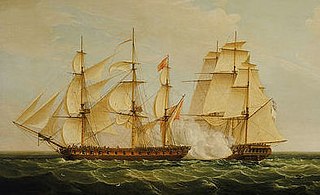
HMS Pearl was a fifth-rate, 32-gun British Royal Navy frigate of the Niger-class. Launched at Chatham Dockyard in 1762, she served in British North America until January 1773, when she sailed to England for repairs. Returning to North America in March 1776, to fight in the American Revolutionary War, Pearl escorted the transports which landed troops in Kip's Bay that September. Much of the following year was spent on the Delaware River where she took part in the Battle of Red Bank in October. Towards the end of 1777, Pearl joined Vice-Admiral Richard Howe's fleet in Narragansett Bay and was still there when the French fleet arrived and began an attack on British positions. Both fleets were forced to retire due to bad weather and the action was inconclusive. Pearl was then despatched to keep an eye on the French fleet, which had been driven into Boston.

The Mediterranean campaign of 1793–1796 was a major theater of conflict in the early years of the French Revolutionary Wars. Fought during the War of the First Coalition, the campaign was primarily contested in the Western Mediterranean between the French Navy's Mediterranean Fleet, based at Toulon in Southern France, and the British Royal Navy's Mediterranean Fleet, supported by the Spanish Navy and the smaller navies of several Italian states. Major fighting was concentrated in the Ligurian Sea, and focused on British maintenance of and French resistance to a British close blockade of the French Mediterranean coast. Additional conflict spread along Mediterranean trade routes, contested by individual warships and small squadrons.
The Battle of the Levant Convoy was a naval engagement of the French Revolutionary Wars fought on 7 October 1795. During the battle, a powerful French squadron surprised a valuable British convoy from the Levant off Cape St Vincent on the coast of Portugal. The convoy was weakly defended, and although the small escort squadron tried to drive the French back, they were outmatched. In the ensuing action one of the British ships of the line and almost the entire convoy was overrun and captured. The French commander, Commodore Joseph de Richery, then retired to the neutral Spanish port of Cádiz, where he came under blockade.
Sagittaire was a 50-gun ship of the line of the French Navy.

